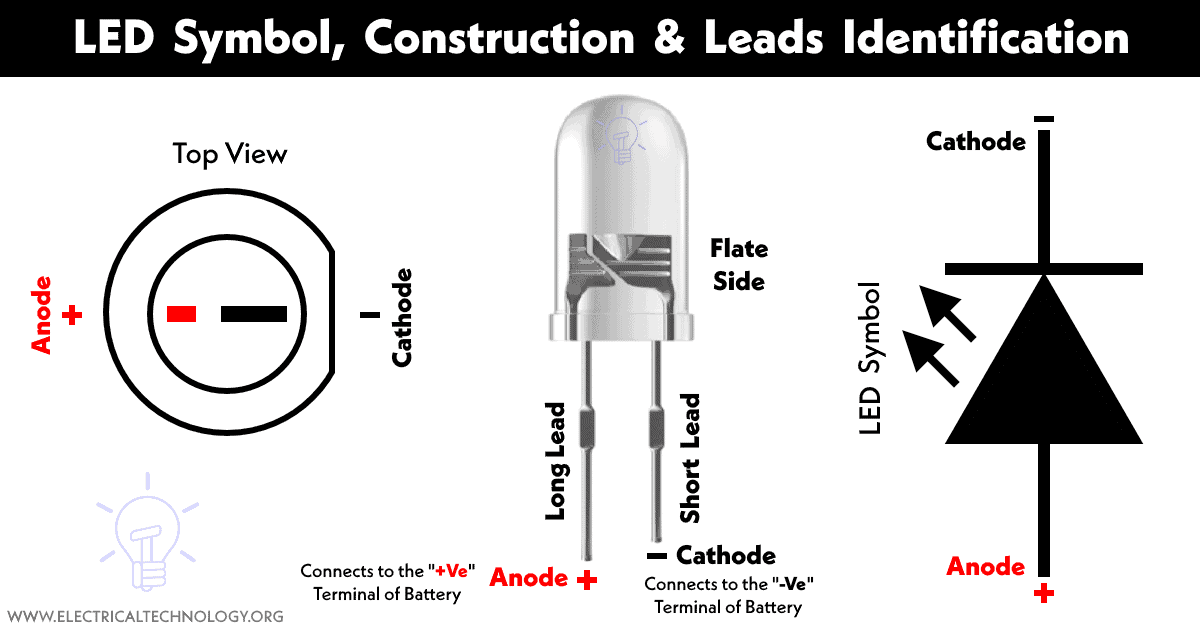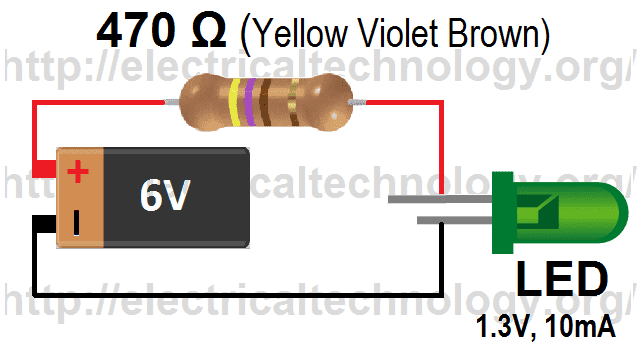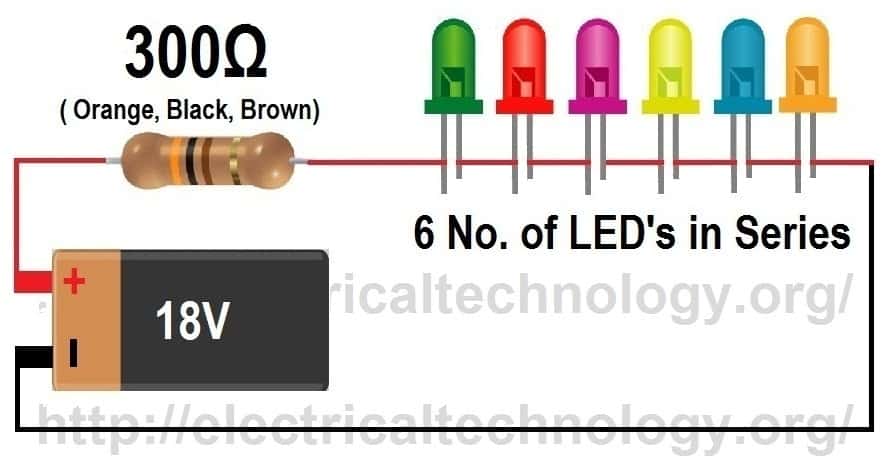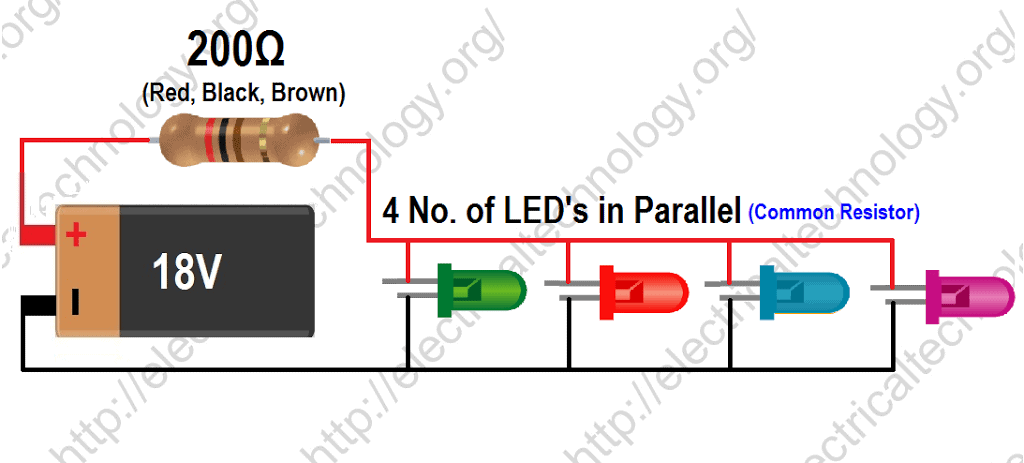How to Calculate the Value of Resistor for LED’s & Different Types of LED Circuits
How to Find the Value of Resistor for Different Types of LEDs Circuits
The following step by step tutorial will help you to find the proper value of a resistor (or resistors) for one or more LEDs and LEDs string circuits to design and connect with battery and power supply.
In the following guide, you will be able to learn how to:
- Calculate the value of resistors for different LEDs circuits.
- Calculate the forward current of LEDs.
- Calculate the Forward Voltage for different LEDs circuits.
- Connect LEDs in series with a battery.
- Connect LEDs in parallel with a battery.
- Connect LEDs in series-parallel combination circuits.
Update: You can Also use this LED Resistor Calculator for the same purpose i.e. finding the value of exact or nearest standard value of resistor for LEDs circuits.
Related Posts:
- How to Find the Value of Burnt Resistor ( By Four Handy Methods )
- How to Find the Value of SMD Resistors – (SMD Resistor Codes)
Typical LED Symbol, Construction and Leads Identification
Click Image to enlarge
Formula For Finding the Value of Resistor for an LED Circuit
Value of Resistor = (VSupply – VF) ÷ IF
Where:
- VSupply = Supply voltage
- VF = Forward Voltage
- IF = Forward Current
The following formula can be used to calculate the value of power rating of the resistor.
Power Rating of Resistor = IF2 × Value of Resistor
Finding the Value of Resistor to Connect with an LED
Before we go into details, let’s try to evaluate the following simple circuit. This way, it will be easier to determine the value of resistors for other complex circuits.
Click Image to enlarge
Example:
In the above simple LED circuit, the supply voltage is 6V, LED forward voltage (VF) is 1.3 Volt and forward current (IF) is 10mA.
Now the value of resistor (which we will connect in series with LED) for the above circuit would be:
Resistor Value = (VSupply – VF) ÷ IF = (6 – 1.3) ÷ 10mA = 470 Ω
Current draw = 20mA
Resistor Power rating formula for this circuit
Resistor Power Rating = IF2 × Resistor’s Value
= (10mA) 2 × 470 Ω = 0.047W = 47mW
But this is the minimum required value of resistor to ensure that the resistor will not overheat, so it’s recommended that to double the power rating of the resistor that you have calculated, therefore, choose 0.047W × 2 = 0.094W = 94mW resistor for this circuit. Resistor power rating (Value is doubled) = 0.094 W = (94 mW)
Good to Know:
- It is too difficult to find the exact power rating resistors that you have calculated. Generally, Resistors come in 1/4 watt, 1/2 watt, 1 watt, 2 watt, 5 watt, and so on. Therefore, select the next higher value of power rating. For example, if the calculated value of power rating of the resistor is 0.789W = 789mW, then you would select 1W Resistor.
- It is too difficult to find the exact value of resistors that you have calculated. Generally, Resistors come in standard values. If you are not able to find the exact value of a resistor that you have calculated, and then select the next coming value of the resistor that you have calculated, For Example, if the calculated value is 313.5Ω, you would use the closest standard value, which is 330 Ω. if the closest value is not close enough, then you can make it by connecting resistors in series – parallel configuration.
- IF = Forward Current of LED: This is the amount of maximum current that LED can accept continuously. It is recommended to provide 80% of LED forward current rating for long life and stability. For example, if the rating current of the LED is 30mA, then you should run this LED on 24mA. Value of current over this amount will shorten LED life or may start to smock and burn.
- If you are still unable to find the LED forward current, then assume it is 20mA because a typical LEDs run on 20mA.
- VF = Forward Voltage of LED: This is the forward voltage of LED i.e. the voltage drop when we supply the rated forward current. You can find this data on LEDs Packages, but it is somewhere between 1.3V to 3.5V depending on type, color and brightness. If you are still unable to find the forward voltage, simply connect the LED through 200Ω with a 6V battery. Now measure the voltage across the LED. It will be 2V and this is the forward voltage.
Related Posts:
Finding the Value of Resistor to Connect with LEDs in Series
Below is another simple LEDs (LEDs Connected in Series) Circuit. In this circuit, we have connected 6 LEDs in Series. Supply Voltage is 18V, The Forward Voltage (VF) of LEDs is 2V and the forward Current (IF) is 20mA each.
Formula:
Value of Resistor for LEDs in Series = (VSupply – (VF × No. of LEDs)) ÷ IF
Click Image to enlarge
Example:
In the above series LEDs string circuit, the total forward voltage (VF) of 6 LEDs = 2 × 6 = 12V
and forward Current (IF) is same (i.e. 20mA)
(Note: this is a series circuit, so current in series circuit in each point is same while voltages are additive) Now, the value of resistor (for series circuit) would be:
= (VSupply – (VF × No. of LEDs)) ÷ IF = (18 – (2 × 6)) ÷ 20mA
= (18 – 12) ÷ 20mA = 300 Ω
Total Current draw = 20mA
(This is series circuit, so currents are same)Resistor Power Rating
= IF2 × Resistor Value = (20mA) 2 × 300 Ω = 0.12 = 120mW
But this is the minimum required value of resistor to ensure that resistor will not explode. This way, it is recommended to double the value of power rating of the calculated resistor. therefore, choose 0.12W × 2 = 0.24W = 240mW resistor for this circuit. Resistor power rating (Value is doubled) = 0.24 W = (240 mW).
Finding the Value of Common Resistor to Connect with LEDs in Parallel
Click Image to enlarge
In this circuit, we have connected LEDs in parallel with a common resistor. Supply Voltage is 18V, The Forward Voltage (VF) of LEDs is 2V and the forward Current (IF) is 20mA each.
Formula:
Value of Common Resistor for LEDs in Parallel = (VSupply – VF) ÷ (IF × No. of LEDs)
Example:
Here, the total forward Current (IF) of 4 LEDs = 20mA × 4 = 0.08A, and forward Voltage (VF) is same (i.e. 2V)
(Note: this is a parallel circuit, so voltage is the same in each point while currents are additive).
Now, the value of resistor (for parallel Circuit with common resistor) would be:
= (Vsupply – VF) ÷ (IF × No. of LEDs)
= (18 – 2) ÷ 0.08
= 200 Ω
Total Current draw = 20mA × 4 = 80mA
(This is parallel circuit, so currents are additive)
Resistor Power Rating = IF2× Resistor Value= (20mA) 2 × 200Ω = 0.08 W = 80mW
As before, this is the least required value of resistor that will will not overheat and explode. Therefore, it’s recommended to double the power rating of the calculated resistor. This way, choose 1.28W × 2 = 2.56W resistor for this circuit. Resistor power rating (Value is doubled) = 2.56W (280 mW).
Finding the Value of Separate Resistor to Connect with LEDs in Parallel
Click Image to enlarge
This is another way to connect LEDs in parallel with separate resistors. In this circuit, we have connected 4 LEDs in parallel with separate resistors. Supply Voltage is 9V and the Forward Voltage (VF) of LEDs is 2V and the forward Current (IF) is 20mA each.
Formula:
Value of Separate Resistor for LEDs in Parallel = (VSupply – VF) ÷ IF
Example:
In this case, the total forward voltage (VF) of LEDs = 2 and forward Current (IF) 20mA (i.e. 20mA)
(Note: this is a parallel circuit, but we are finding the value of the resistor for each section, not for the whole circuit. So in each section, the circuit becomes in Series position (refer to the Series Circuit formula or the 1st simple circuit above, you will find that these are same)
Now, the value of resistor (for parallel Circuit with separate resistors) would be:
= (VSupply – VF)/ IF= (9 – 2) ÷ 20mA = 350 Ω
Total Current draw = 20mA × 4 = 80mA (This is parallel circuit, so currents are additive)
Resistor Power Rating = IF2 × Resistor Value= (20mA) 2 × 350 Ω = 0.14 = 140mW
Same like the above scenarios, the calculated value of the resistor is the minimum required value to safely connect in the LED circuit. To be on a safe side, it is recommended to double the power rating of the calculated resistor. Hence, choose 0.14W × 2 = 0.28W = 280mW resistor for this circuit. Resistor power rating (Value is doubled) = 0.28 W (280 mW).
There is another way to connect LEDs with batteries in series-parallel combination and yes, you will need a proper resistor(s) for that purpose too. But if you understand this simple calculation based tutorial, then I’m sure that you can easily determine the value of resistors for series-parallel combination based LEDs connections and circuits as well.
Related Posts:
- How to Find the Proper Size of Circuit Breaker? Breaker Calculator & Examples
- How to Find The Suitable Size of Cable & Wire for Electrical Wiring Installation? – Examples in Imperial & Metric System
- Find Voltage & Ampere Rating of Switch, Plug, Outlet & Receptacle
- How to Find the Number of Lights on a Single Circuit Breaker?
- How to Find the Number of Outlets on a Single Circuit Breaker?
- How to Size and Find the Numbers of Ceiling Fan in a Room?
- How to Find P.F Capacitor in µF & kVAR?
- How to Find the Size of Earth Conductor, Earthing Lead & Earth Electrodes?
- How to Calculate the Right Size Battery? Battery Bank Size Calculator
- How to Calculate the Right Size of Solar Charge Controller?
- How to Calculate the Number of Fluorescent Lamps in a Final Sub Circuit?
- How to Calculate the Number of Incandescent Lamps in a Final Sub Circuit?
- How to Calculate the Suitable Capacitor Size in µ-Farads & kVAR for P.F Improvement
- How to Calculate the Battery Charging Time & Battery Charging Current – Example
- How To Calculate Your Electricity Bill. Electric Bill Calculator with Examples
- How to Determine the Suitable Size of Inverter for Home Appliances?
- How to Determine the Right Size Capacity of a Subpanel?
- How to Determine the Number of Circuit Breakers in a Panel Board?
- How to Size a Load Center, Panelboards and Distribution Board?
- How to Size a Single Phase and Three Phase Transformer in kVA? Calculator
- How to Size a Generator? Portable, Backup & Standby for Home & Commercial Applications












Its very usefully for Electrical Engineer
there are some errors in current value substitution in equations..<br />please correct it<br />
Dear Tony Stark. please mention it. Thanks
There is need to correction here (18 – (12 x 6) / 20mA = 300 Ω) If the calculation will be as this there would be negative value -2700. Please check & advice. There Should Be as this<br />(18 – (2 x 6) / 20mA = 300 Ω)
Ya sure..we had put 12 instead of 2. Thanks for correction
Dear,<br />I Think here is also need of correction "Resistor Power Rating = IF2 x Resistor Value<br />= (20mA) 2 x 200Ω = 1.28 W" It might be 80mW <br />
For the single resistor and parallel LEDS: the 20mA is incorrect for the total current through the resistor. It should be 20mA x 4 = 80mA. Thus the minimum power for the resistor is 1.28W
quantum physics determines the forward voltage drops of leds (and any diode)<br />depending on the materials in the PN junction<br />some ir diodes as low as 1.5v<br />UV diodes as high as 4.5V<br />a lot of the white ones are florescent lamps a UV diode exciting phosphors <br /><br />If you parallel different colors red will take all the current and blue wont light at all <br /><br />if you have
Hi I need to exacly know how this works when this LEDs connected to main supply (230 V A/C ) how do I do the calculation for dropdown resistor & capasitors <br />I work with LED Lamp circuits & it is very importan to me to know this <br /><br />hope you will help me <br /><br /><br />TY <br />Senarath <br />senarathdon@yahoo.com
HI,<br />I need to know how this calculation gose when LEDs are connected to main(230v A/C) how do I calculate the resisted valu & the Paralel capasitor valu <br /><br /><br />Thank you <br /><br />Senarath<br />senarathmdon@yahoo.com
https://www.electricaltechnology.org/2013/03/230-v-ac-main-operated-led-powerful.html
Thank you very much.<br />It's very helpful for me.
I was in need of this formula. God bless you.<br />thanks a lot.<br /><br />Sohail Ahmad sambapk@yahoo.com
I have other solution to solve the prlboem.I used mesh analysis and others tools. I’ll explain how to get the results.We have tres values: See the image here:It’s not necessary resolve three equations by the mesh cause we know two of them. We only need do our mesh 1 equation:I puted two nodes on the circuits to have more information about the currents that we have.Node A = 0Node BWe have then:We could be more exactly in our equations to find Ix and I1Solving that:In this way, with one of our equation we could fin the other value:To find the , we could do a simple KVL across the mesh 2.
A genuine question as I’m trying a torch conversion. Why is the sum IF² ( = 400mA ) x Resistor value ,when the Total draw is 80mA ( 20mA x 4)?
Should it be 80mA x 350 = 0.28w = 280mw.
“”Total Current draw = 20mA x 4 = 80mA (This is parallel circuit, so currents are additive)
Resistor Power Rating = IF2x Resistor Value
= (20mA) 2 x 350 Ω = 0.14 = 140mW””
Yes!… for 4 number of LED’s Parallel Circuit, it would be 80mA x 350 = 0.28w = 280mw.
There are 40 led of 3.2 v and 60 ma of each led,combination is 8 in series and 5 in parallel. Current for whole led PCB is. ???? On 220 v ac.explain how to find wattage and current
Hi
I want to connect 300 resistor in parallel, can it will be possible to do this. And how much voltage should I pass through this circuit.please help me,As soon as possible
Can you provide an example using a Tri-Cree star LED module that is 750 mA instead of 20 mA, and a 3.7v li-ion cell 5000 mAh rating… if Vf is 2.8v for each RED die on the star pad… then what type of resistor would be used to satisfy these requirements, Ohms and Watts???
Ideally, if using a RGB star, each die has its own resistor based on Vf of red, green, and blue dies, AND, the I= values for mA draw of each die type, i.e. 750 red, 1000 blue or green, etc.
What if ledsupply.com only wired all 3 red dies in PARALLEL with only 2 wires exiting the heatsink module? I can’t use 3 seperate resistors now.
I understand that three dies in a star in parallel would draw 3000 mA and would damage a 2500 mAh cell, yes? I’m using a 5000 mAh cell 3.7v li-ion so it should do ok.
Also, if you are using a n-MOSFET to control this circuit, separate from a microcontroller (arduino) how can you determine if enough voltage is left and current to power a 5v 500mA boost breakout circuit, that powers the 5v microcontroller?
I am probably wrong… but I chose to buy at RadioShack a 0.47 Ohm 5watt ceramic resistor looks big and white rectangle shape. It seems to work for my red Tri-Cree module where I soldered the neg pads in series and used seperate wires (3) on the pos pads. I connected the resistor to the 3 wires…
Is that close, hot, or COLD?
I was told to use a 1 Ohm 2watt resistor for a single die blue 3w led and 3.7v cell. Or 2 Ohm, 1 watt… first sounds right…
Red only handles 750 mA compared to blue which requires 1000 mA. So, would my choice 0.47 ohm resistor 5watt be a bad choice based on this logic? It would allow more current than the 1 Ohm.
Thanks for listening and hopefully for ANSWERING my questions for this project. A module is $30 investment so I don’t want to sizzle it. Not fun.
Dave Hartman
Learning about electronic circuitry
I’m not an electrical engineer. I was thinking o f my strands of led Christmas lights. If you buy a 100 bulb strand it is basically two fifty bulb strands hooked together with what appears to be a in line resistor now that i’ve been reading your site. I have several that half the strand goes out. I know the bulbs are perfect and there is a manufacture number on the resistor but it doesn’t show the ohms and the information needed to calculate it is not on the box that i can tell. I’m certain that the replacement resistor is inexpensive. How would i solve the 110v AC mystery of my led light strand?
If the bulbs can be disconnected from the strand, disconnect the bulb and use a multimeter and put the settings to ohms and place the leads on the terminals of a single working bulb or if the resistor is exposed then place the leads on that and that should give you the resistance value.
hello
i want to calculate the series resistor for two series led’s
Vs=12v
LED vf=1.7v if=20ma and,
Opto IR LED vf=1.5 if=10ma
thanks.
Are those ‘wizard’ websites that calculate for me incorrect, by not adjusting to 80% of forward current, or are they just going by the letter of the (Ohms) law?
Just to compare the two results, I will build 5×10 LED chains (1.5V, 60mA) off 19V power supply.
Calculations from your equations give me 82R,0.5W resistor in each chain, the wizard says 68R,0.5W (figures rounded up) – I understand that I should use the higher-rated resistor for reliability of the LEDs?
How to calculate capacitor value for led in parallel with capacitor???
Depends on what your input voltage is and what are you trying to charge or how long are you capacitating energy? There are a lot of factors you need to know for your application of capacitors in your circuit. Follow coulomb’s law. Most commonly used capacitors are in microfarads (uf)
If we have series and parallel combination in one circuit then how this formula will work.. Kindly somebody help on this.
This ignores the fact that different colors of LED’s have different values for forward voltage. For example, the voltage across an LED can vary from 2.0 volts to 3.2 volts or more depending on manufacturing and color. This would affect the current limiting resistor value for a given source voltage.
Also, due to manufacturing variations you might need to consider current draw for LED’s may vary so for strings of LED’s in series or in parallel you might want to consider a constant current power source.
To maximize efficiency, and minimize loss, using an appropriate source voltage should be considered.
LED Circuit issue Hi, Iam using 1Watt Warm white LED in series of Qty 13nos. with driver 48V, 350ma. there is no resistor in this so please suggest the Resistor value to put into this circuit. If i take Voltage across LED is 3.3V and current is 340ma. please advise the resistor value and wattage.